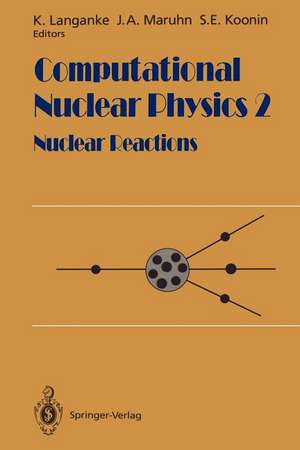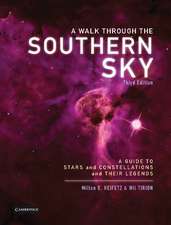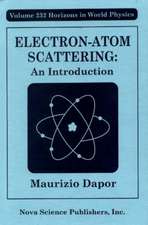Computational Nuclear Physics 2: Nuclear Reactions
Editat de K. Langanke, J. A. Maruhn, S. E. Kooninen Limba Engleză Paperback – 18 oct 2011
Preț: 723.06 lei
Preț vechi: 881.78 lei
-18% Nou
Puncte Express: 1085
Preț estimativ în valută:
138.35€ • 144.84$ • 114.48£
138.35€ • 144.84$ • 114.48£
Carte tipărită la comandă
Livrare economică 08-22 aprilie
Preluare comenzi: 021 569.72.76
Specificații
ISBN-13: 9781461393375
ISBN-10: 146139337X
Pagini: 220
Ilustrații: XIV, 203 p.
Dimensiuni: 155 x 235 x 12 mm
Greutate: 0.31 kg
Ediția:Softcover reprint of the original 1st ed. 1993
Editura: Springer
Colecția Springer
Locul publicării:New York, NY, United States
ISBN-10: 146139337X
Pagini: 220
Ilustrații: XIV, 203 p.
Dimensiuni: 155 x 235 x 12 mm
Greutate: 0.31 kg
Ediția:Softcover reprint of the original 1st ed. 1993
Editura: Springer
Colecția Springer
Locul publicării:New York, NY, United States
Public țintă
Professional/practitionerCuprins
1. One-Boson-Exchange Potentials and Nucleon-Nucleon Scattering.- 1.1 The Meson Theory of Nuclear Forces.- 1.2 Relativistic Two-Nucleon Scattering.- 1.3 One-Boson-Exchange Potentials.- 1.4 Numerics and Codes.- 1.5 Using the Codes.- 1.6 What Else?.- Acknowledgments.- References.- 2. The G-Matrix in Finite Nuclei.- 2.1 Introduction.- 2.2 The G-Matrix, a First Step Towards an Effective NN Interaction.- 2.3 The Solution of the Bethe-Goldstone Equation.- 2.4 Details of the Numerical Calculation.- 2.5 Some Examples for Tests and Studies.- 2.6 Technical Note.- References.- 3. The Nuclear-Matter Effective Interaction.- 3.1 Background.- 3.2 The Bethe-Goldstone Equation in Uniform Matter.- 3.3 The Reference Spectrum Method.- 3.4 The Legindgaard Representation.- 3.5 Numerical Methods.- 3.6 Remarks on the Code.- 3.7 Performance.- 3.8 Things to Do.- References.- 4. Microscopic Description of Nuclear Collisions.- 4.1 Introduction.- 4.2 Theoretical Background to the Resonating Group Method.- 4.3 A Short Description of the Numerical Methods Used and the Program Structure.- 4.4 Installation and Use of the Codes.- 4.5 Physical Applications.- 4.6 Technical Note.- References.- 5. The Distorted-Wave Born Approximation.- 5.1 General Description of DWUCK4.- 5.2 Specific Cases of Reactions.- 5.3 Description of the Input for DWUCK4.- 5.4 Sample Cases-Input and Output.- 5.5 Things to Do.- 5.6 Technical Note.- References.- 6. Statistical-Model Calculations with Angular-Momentum Coupling.- 6.1 Background.- 6.2 Basic Features of the Code.- 6.3 Level-Density Tables.- 6.4 Transmission Coefficients.- 6.5 Fission Barrier and Probability.- 6.6 Angular Distribution.- 6.7 Special Programming Features.- 6.8 Input and Output Files.- 6.9 Summary.- 6.10 Technical Note.- References.- 7. The Time-Dependent Hartree-Fock Approximation for Nuclear Slabs.- 7.1 Background.- 7.2 Interaction.- 7.3 Reduction to One Dimension.- 7.4 Numerical Methods.- 7.5 Remarks on the Code.- 7.6 Running the Code.- 7.7 Things to Do.- References.- 8. The Vlasov-Uehling-Uhlenbeck Model.- 8.1 Introduction.- 8.2 Theoretical Description of Heavy-Ion Collisions.- 8.3 The VUU Equation.- 8.4 The Nuclear Equation of State.- 8.5 Numerical Realization.- 8.6 The Basic Structure of the Program.- 8.7 Running the Program.- 8.8 Input Examples.- 8.9 Interpretation of the Output.- 8.10 Output Analysis with VUUANL.- 8.11 Final Comments on Using the Program.- 8.12 Test Output.- References.- 9. The Friction Model for Deep-Inelastic and Fusion Reactions.- 9.1 Introduction.- 9.2 Description of the Program.- 9.3 The Structure of the Final Printout File.- 9.4 Running the Code with the Sample Input.- References.- 10. The Quark Model and the Nucleon-Nucleon Interaction.- 10.1 Introduction.- 10.2 The Resonating Group Method.- 10.3 The Hamiltonian of the Six-Quark System.- 10.4 Remarks on the Code.- 10.5 Technical Note.- References.- 11. Hadron-Hadron and Hadron-Nucleus Scattering.- 11.1 Introduction.- 11.2 Multiple Scattering Off Nuclei.- 11.3 Hadronic Interactions in the Quark Model.- 11.4 Conclusion.- 11.5 Technical Note.- References.














